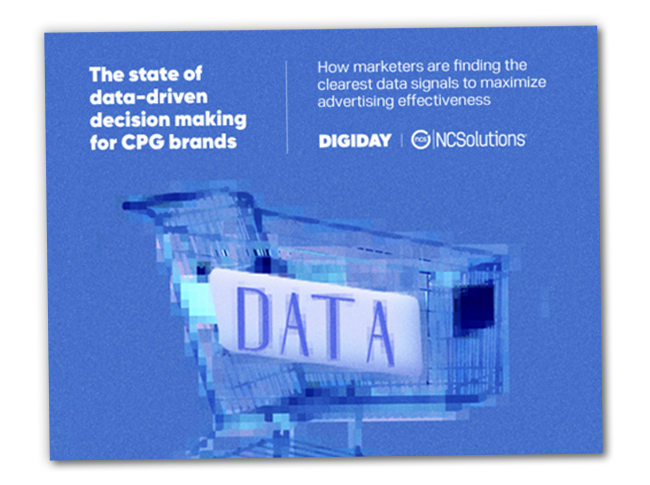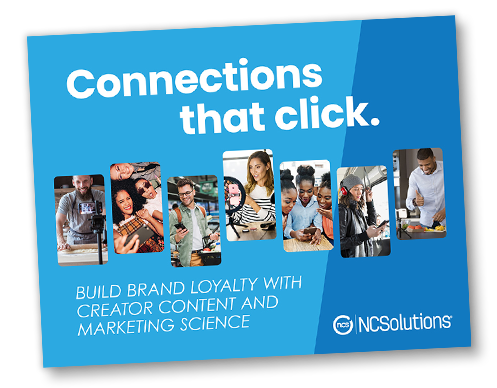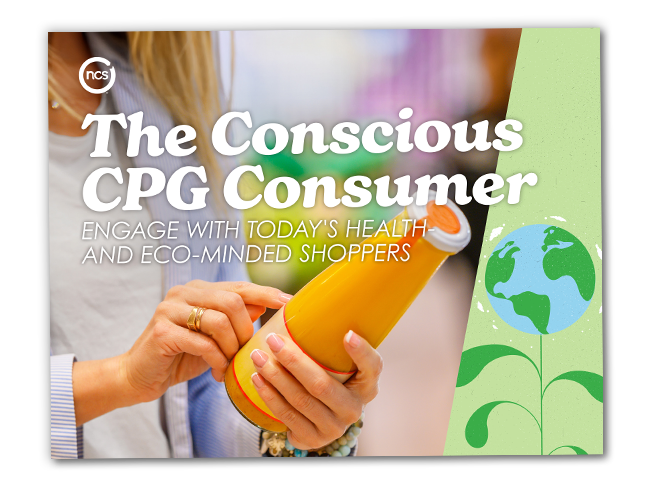Menu
By NCS Marketing
For CPG brand marketers and their partners, garnering engagement on an ad campaign is no longer enough to rank it a success: It needs to drive people to buy. In fact, more than 64% of CPG marketers use sales lift to measure the impact of their campaigns.¹ One way to help ensure that your campaign drives sales is to more or less whisper into the ears of folks who are already interested in your product. (But at scale, and with no actual ears or whispering involved.)
Enter purchase-based targeting (PBT), the audience targeting solution for connecting with the households most likely to buy. In short, PBT uses previous purchase behavior to identify the right audiences to serve ads to. It can drive greater return on ad spend (ROAS), extend brand reach, and increase incremental sales, which is why 68% of CPG brand marketers already rely on PBT for their campaigns.²
PBT has been around for decades, starting with the advent of loyalty programs that supermarkets and department stores use to collect customer data and remarket to them. Today, while 80% of Americans are a member of at least one loyalty program, according to a report by Lending Tree, targeting solutions have evolved and multiplied, thanks to technological advancement, shaped by brand marketers’ need for efficiency and results. "Purchase-based targeting is evolving, allowing CPG and OTC brands to activate audience segments confidently using comprehensive data from multiple retailers. This approach reflects U.S. household buying habits and enables brands to reach their ideal customers with precision and effectiveness," according to Steven Tramposch, senior vice president of client consulting at NCS.
Jump to:
- What is Purchase-Based Targeting?
- Why Use Purchase-Based Targeting?
- How Do You Use Purchase-Based Targeting?
- Examples of PBT Campaigns
- PBT FAQs
What is Purchase-Based Targeting?
Let’s cut to the chase: Purchase-based targeting is the strategy that ensures your marketing campaigns hit the bullseye—the households most inclined to buy. In a nutshell, the definition of purchase-based targeting is using past buying behavior to pinpoint the households most likely to respond to your ads. Unlike demographic, contextual, or interest-based targeting, PBT filters for the best audiences based on buying behavior. It’s the smart, data-driven way to connect with your best potential customers. For CPG brands, whose products are largely sold in brick-and-mortar stores PBT is crucial because it bridges the gap to their end users, enabling marketers to precisely and effectively reach their customers without direct access to consumer data.
How Purchase-Based Targeting (PBT) Works
You can think of purchase-based targeting as your marketing GPS, guiding you to the right audiences by using the most reliable signals—purchase data. And while the methodology behind it is sophisticated, the steps are straightforward. Here’s how it works:
- Data Collection: Both in-store and online purchase data are captured.
- Data Analysis: This data is analyzed to unearth insights about the households that purchased a brand’s products or similar items across stores.
- Audience Modeling: Once the data is analyzed, those valuable insights on buyers are used to create models that predict which U.S. households are most likely to buy. It’s like making an ideal customer profile based on buying habits.
- Audience Delivery and Ad Serving: Once the audiences are built, NCS delivers them to demand-side platforms (DSPs) and publishers, ready for brands and agencies to activate seamlessly within their campaigns.
Ads are tailored and served to these households and individuals, ensuring your message reaches prospects who are likely to take action.
Why Use Purchase-Based Targeting?
PBT isn’t just effective—it offers better return on ad spend (ROAS) than other targeting methods. Just as important, it’s a shape-shifter, fitting snugly into your marketing plan. As Colleen Dummeyer, vice president of client consulting at NCSolutions, puts it, “Purchase-based targeting can be applied to any campaign, regardless of goals or platforms.”

Reach Your Best Buyers With Precision
With PBT, your ads land precisely where they should—on the screens of folks who’ve already shown interest in your product or category through their purchase behavior. You’re reaching the veritable hand-raisers—the people who’ve already voted with their wallets. Imagine you’re selling a new line of allergy medication; with PBT, you’re not just advertising to the broad universe of folks with noses, but specifically to those who’ve already bought allergy products and are likely to again. Like crowd lights spanning the crowd and illuminating the most fervent Swifties at a Taylor concert, PBT shines a light on the consumers who matter most to the health of your business.
Increased ROAS
Efficiency is the name of the game. PBT allows you to allocate your advertising budget more effectively, reaching consumers more likely to convert. This efficiency translates to higher profits and a better return on ad spend (ROAS)—3x better than other targeting methods.
Insights That Strengthen Business
The better you know your customers, the more effectively you can market and sell to them, right? PBT uncovers deeper insights into the shopping habits and preferences of buyers of your product and similar items. By understanding what other products your typical buyer tosses in their cart, how often they buy and more, you can tailor your offerings and marketing strategies to reach them. You can use these insights to inform future campaigns, product development and customer service improvements, creating an upward spiral.
Overcome Common Marketing Challenges
It’s sure not an easy time to be a marketer (was there ever an easy time to be a marketer?), but PBT can help on a couple of fronts:
- Sourcing Representative Data: High-quality, accurate data is essential for effective targeting. Sourcing it can be a complex endeavor, but you don’t have to do it yourself. NCS has purchase data from big-box retailers, supermarkets, drug stores, convenience stores, receipt capture, grocery delivery, and other retail channels, to represent the purchase behavior of all U.S. households at all retail outlets.
- Ensuring Data Privacy: To play fair, you need to follow laws like GDPR and CCPA, protecting people’s info. Brands have several options for data sources, but making sure the data is privacy compliant is a must. At NCS, we don't have access to any personally identifiable information (PII) and go through a rigorous process to ensure it’s privacy-compliant.
- Achieving Personalization at Scale: Consumers now expect personalized experiences, and through sophisticated segmentation, PBT enables brands to deliver tailored messages based on a household’s buying behavior, increasing engagement and loyalty.
- Increasing Ad Budget Efficiency: Maximizing the ROI of every marketing dollar is important. PBT ensures that ad spend is directed towards the consumers most likely to convert, for more efficient campaigns.
How Do You Use Purchase-Based Targeting?
To build a successful CPG brand, you must keep your current customers happily returning while bringing in fresh faces. Remember Chutes and Ladders? You’ve got to bring in new customers (the first rung of the ladder), nourish the occasional buyers in the middle rungs to increase their loyalty, and remember your most devoted customers, too—or down you slide. As Dummeyer puts it, “Brands must be conscious about maintaining and growing their current consumer base, while also recruiting new buyers—either through awareness or competitive conquesting.” It’s a balancing act, but with PBT you can get that balance right by targeting each group consistently and moving them up the loyalty ladder. Try these strategies:

Extend Your Reach and Bring in New Brand Buyers
To welcome new buyers onto your ladder, target a purchase-based audience of households buying products in your category to reach the consumers most likely to convert without overspending.
Turn Non-Loyal Buyers into Brand Switchers
Conquest sometimes-buyers by targeting medium-loyal buyers of your brand and heavy category buyers who haven’t yet started buying your brand. This strategy nudges non-loyals up a rung toward becoming loyal customers.
Retain Loyal Brand Buyers
Keep your loyal fans devoted by targeting heavy loyal brand buyers and heavy category buyers who are brand switchers with tailored offers. Show them some love; they’re likelier to do the same for you at checkout, maintaining their top spot on the ladder. Ads targeting existing buyers drive more incremental sales than those targeted to new buyers or aren’t targeted at all, according to NCS research.
Common Strategies and Best Practices
To squeeze the most from PBT, follow these strategies:
- Choose the Right PBT Audience Solution: Pick a solution that supports your goals and works within your budget and timeline. NCS offers custom audience segments and access to over 1,000 pre-defined public audiences across 300+ categories and 600+ brands.
- Ensure High-Quality Data: NCS’s representative and balanced CPG purchase data set consists of the industry’s most comprehensive sources. It includes transaction information from big-box retailers, supermarkets, drug stores, convenience stores, and other retail channels, reflecting how Americans shop for 340+ grocery categories.
- Embrace Machine Learning: Use advanced analytics to model and target precise audiences. At NCS, we use advanced machine learning to model our data to represent the purchase behavior of all U.S. households and retail outlets.
- Craft Relevant Creative: While audience targeting is important, creative is just as essential. You need to tailor your creative messaging to fit your brand goals for maximum impact. Creative quality is responsible for 49% of incremental sales generated by advertising, per NCS research.
Examples of Purchase-Based Targeting Campaigns
Looking for real-world examples to help you understand the value and impact of PBT? They’re right here.
Roku Uses PBT to Drive More ROAS With Fewer Impressions
Roku sought to improve advertising performance for a personal care brand. They’d used demo targeting in a previous campaign, but wanted to ramp up ROAS. NCS delivered custom-built audiences for Roku of previous brand and heavy category buyers.
The Outcome: Through PBT, Roku delivered 35% more incremental sales than the previous campaign with fewer impressions. It also more than doubled incremental sales per household vs. the prior campaign.

PBT Delivers 2X More ROAS Than Other Targeting for a Soft Drink Brand
A big-name beverage manufacturer sought to determine the winning way to target their customers. They wanted to see which method would give them the best ROAS, so the soda stalwart set up a head-to-head test comparing NCS’ PBT, a competitor’s PBT, and the brand’s business-as-usual (BAU) affinity audience targeting. Using advanced analytics and machine learning, NCS built precise audiences based on real-world purchase behavior.
The Outcome: NCS PBT beat the competition, delivering 2x the ROAS as the competitors’ PBT. The BAU strategy also fell flat in comparison to the fizz of NCS PBT. With NCS PBT, the bev brand discovered the impactful, efficient targeting solution they thirsted for.
Purchase-Based Targeting FAQs
Who Can Use Purchase-Based Targeting?
CPG marketing leaders regularly use PBT to reach their customers, but leaders in other industries, such as fintech, restaurants and hospitality, can use the insights revealed through PBT to reach their best buyers. For instance, a coffee chain could use purchase-based targeting to reach households who frequently buy in the coffee category encouraging them to pick up a coffee while they’re out and about.
Where Can I Access Purchase-Based Audience Segments?
If you’re using NCS audiences, we have 1,000 pre-defined public audiences across 600+ brands, 300+ categories readily available at all the DSPs and publishers you’re probably advertising on, and can help you activate the right segments to reach your business goals. Don’t see what you need or looking for something more custom? We can help you.
Is Purchase-Based Targeting Different From Retailer Shopper Data?
Yep. PBT is more comprehensive than retailer shopper data. Retailer shopper data, used by retail media networks, provides a narrow view of customer buying habits by telling you how much a customer spends on a product at the retailer’s store. On the other hand, a strong purchase-based target tells you how much the customer spends across all stores. If an advertiser has a goal of increasing sales anywhere, a broad purchased-based approach is more suitable.
How Do I Know if My Purchase-Based Targeting Strategy is Working?
You can know that your PBT campaign was effective by looking at the metrics that matter most: ROAS and incremental sales lift. By understanding what audience segments performed best, you can build on that success. At NCS, in addition to PBT, we can measure the effectiveness of your campaign too, delivering the granular, precise insight you need to gauge success, lean into what’s working, and shape your future strategy.
Is Purchase-Based Targeting Different From Interest-Based Targeting?
Yes, it sure is. PBT uses consumer purchase data to create targeted marketing campaigns, identifying consumers likely to be interested in similar products or services. Interest-based targeting relies on data on consumers' hobbies, interests, and favorite activities as indicated by their online behaviors, such as the social pages they like and more.
Is Purchase-Based Targeting Different From Behavioral-Based Targeting?
Unlike PBT, which is based on actual purchase behavior, behavioral-based targeting involves using data about consumers' online activities and behaviors to deliver relevant ads (such as browsing history, search queries, clicks, social media interactions, and more).
Where Does Purchase Data Come From?
NCS segments are built on real-world online and in-store purchase behavior data from various sources, including grocery, convenience, drug, mass market, e-commerce, club, delivery app, and more. We ensure our data is of the highest quality and that it’s privacy-compliant. Using our proprietary machine learning, we model purchase insights to serve relevant advertising with precision.
How Impactful is Purchase-Based Targeting?
PBT results in 3X more ROAS than other methods because it’s based on historical buying data, allows for precise audience segmentation, uses machine learning, and provides a feedback loop for continuous improvement. Targeting strategies are now responsible for 11% of incremental sales, up from 9% in 2017, according to NCS research. So yes, it’s extremely impactful.
Want to explore how purchase-based targeting can help you meet your marketing goals? Whether you’re trying to retain your loyal customers, acquire new ones or conquest buyers from competitors, NCS offers you proven audience segments aligned to your goals and consultative teams invested in your success. Connect with us today to start achieving better outcomes.
¹ NCSolutions & CMO Council, Optimizing Outcomes in Media Marketing, 2023
² Brand Innovators & NCSolutions CPG Marketers Survey 2022
Subscribe for Updates
GET INSIDE THE MINDS OF CPG BRAND MARKETERS
Learn about their data-fueled strategies
SNAG YOUR COPY OF THE REPORT TODAY
WONDERING HOW CONSUMERS RESPOND TO INFLUENCER MARKETING?
See how creating content drives results
DOWNLOAD YOUR COPY NOW
WANT TO KNOW MORE ABOUT HEALTH AND ECO-MINDED SHOPPERS?
Get CPG insights to engage your buyers
ACCESS THE E-BOOK TODAY


.png)
.png)


